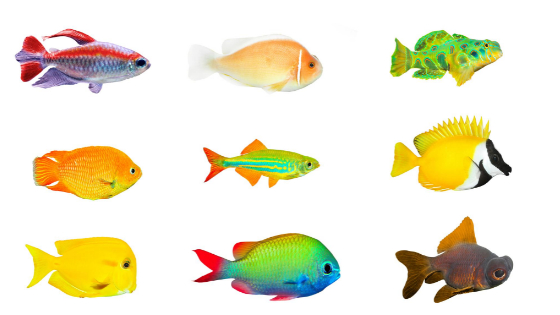
Welcome to the wonderful world of guppies!
These vibrant and vivacious fish are a sight to behold in any aquarium. From their dazzling colors to their playful nature, guppies are sure to captivate your attention.
But there's more to these little swimmers than meets the eye. In this beginner's guide, we will uncover the secrets of guppy care, explore the best tank mates for these friendly fish, and even delve into the fascinating world of aquarium lighting.
So, get ready to dive in and discover the vibrant world of guppies – you won't want to miss a single fin-fluttering moment!
Key Takeaways
- Guppies are a great choice for beginner aquarists due to their undemanding and hardy nature.
- Guppies should be kept in groups of 6 or more fish for their well-being.
- Suitable tank mates for guppies include mollies, platys, swordtails, and smaller species of tetras.
- Proper lighting is crucial for the growth and health of aquarium plants in a guppy tank.
Guppy Fish Basics
If you're new to keeping aquarium fish, guppies are an excellent choice due to their undemanding nature and vibrant colors. Guppies are freshwater fish that have a small size and a non-aggressive temperament. They're best kept in groups of 6 or more fish and thrive in well-planted aquariums.
Native to North-Eastern regions of South America, guppies have been introduced to various ecosystems around the world. Feeding them is easy as they're omnivores and accept most flake-based aquarium foods. They prefer fairly hard, pH neutral water that's well-oxygenated.
When it comes to tank mates, guppies can coexist peacefully with mollies, platys, swordtails, smaller species of tetras, and gouramis. Overall, guppies are a great choice for beginner aquarists looking for low-maintenance and visually appealing fish.
Guppy Fish Care
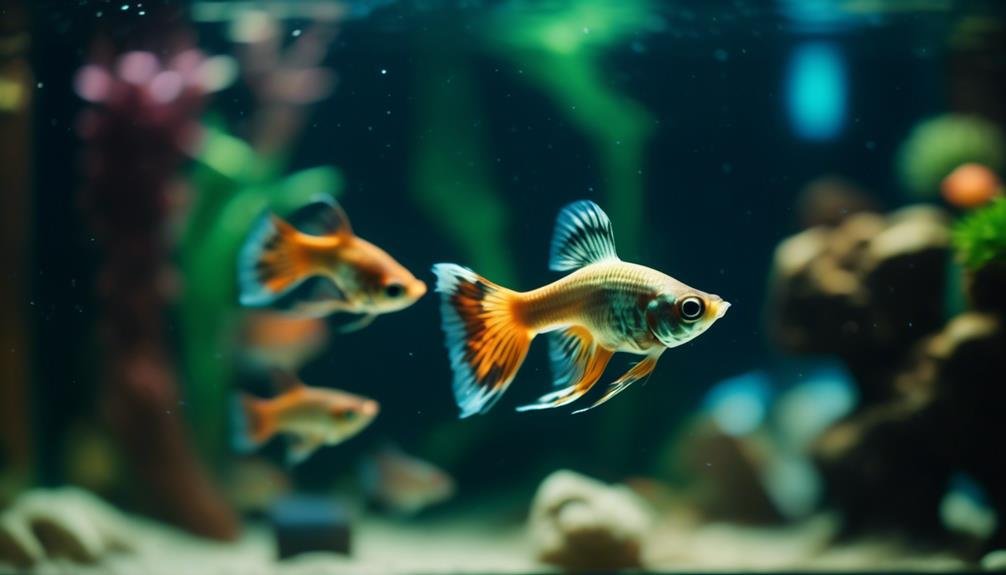
Taking care of guppies is a straightforward and rewarding experience for aquarists of all levels. To ensure the health and well-being of your guppies, here are some important care tips to keep in mind:
- Maintain a suitable tank environment: Guppies thrive in well-planted aquariums with a capacity of at least 30 gallons. Provide them with clean, well-oxygenated water and a neutral pH level.
- Feed them a balanced diet: Guppies are omnivores and will accept most flake-based aquarium foods. Supplement their diet with live foods for optimal nutrition.
- Keep them in groups: Guppies are social creatures and do best when kept in groups of six or more. This will promote their well-being and create a visually pleasing sight in your aquarium.
Suitable Tank Mates
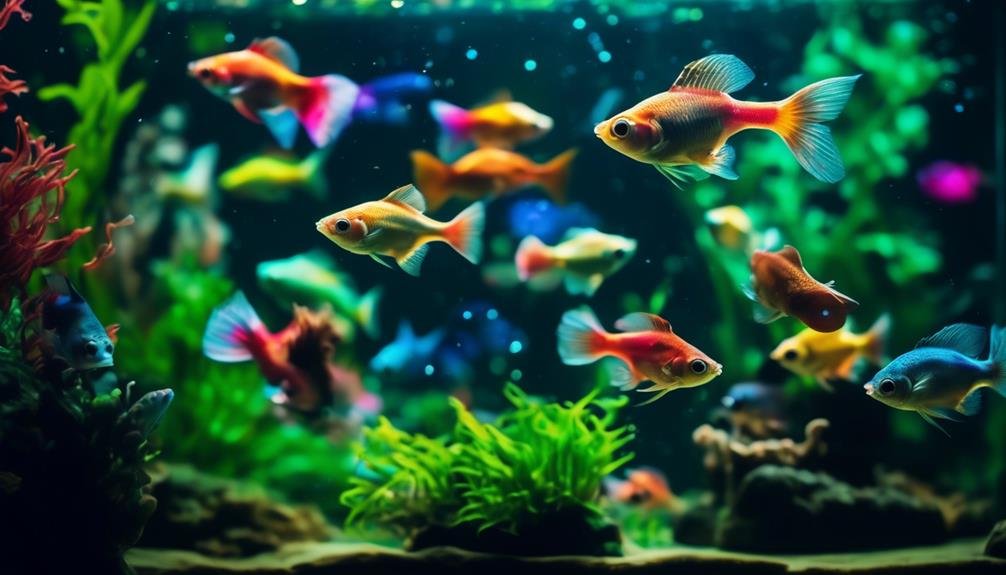
Guppies are best kept in groups of six or more fish.
There are several suitable tank mates that can coexist peacefully with them.
Mollies, platys, swordtails, and other small livebearers are great options.
These fish have similar temperaments and requirements, making them compatible tank mates for guppies.
Smaller species of tetras, like neon tetras and cardinal tetras, also make good companions for guppies.
They add vibrant colors to the tank and are peaceful by nature.
Another suitable option is gouramis, which are visually interesting and get along well with other peaceful species.
Rasboras, with their stunning colors, are also compatible tank mates for guppies.
Gouramis as Tank Mates
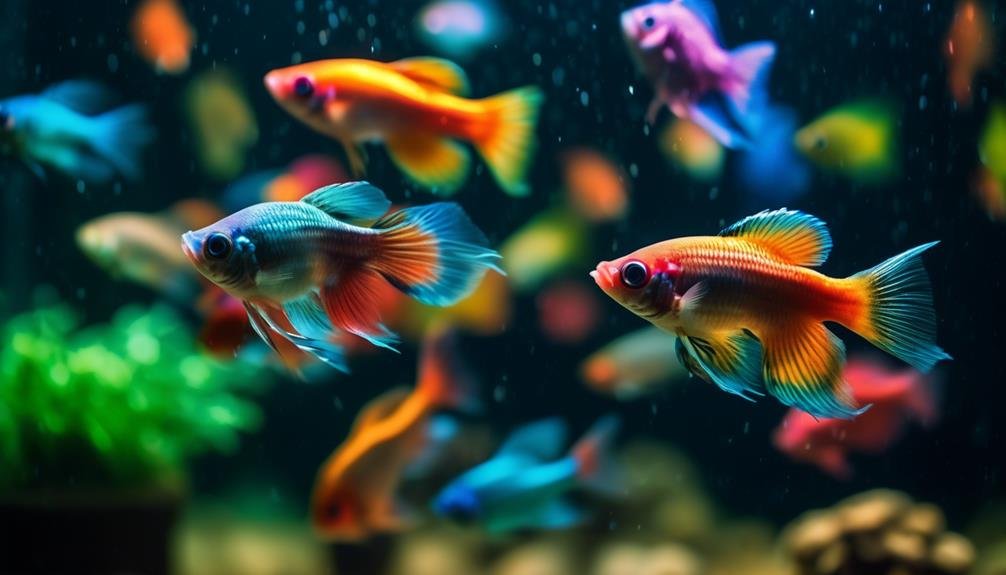
To continue exploring suitable tank mates for guppies, let's now turn our attention to gouramis. Gouramis make excellent companions for guppies due to their peaceful nature and compatibility with other species. Here are some reasons why gouramis are a great choice as tank mates:
- Gouramis show little interest in live aquarium plants, making them a good choice for the planted tank.
- They get along well with other peaceful species, creating a harmonious community in the aquarium.
- Gouramis add visual interest to the tank with their vibrant colors and unique fin patterns.
With their compatibility, aesthetics, and ease of care, gouramis are a fantastic choice to accompany your guppies in the aquarium.
Rasboras as Tank Mates
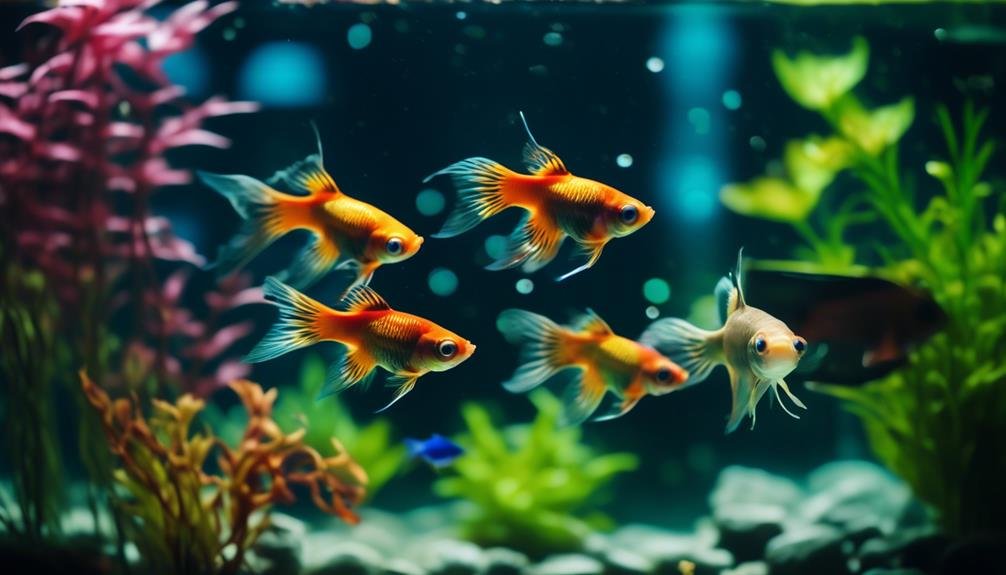
Rasboras can be a great choice as tank mates for guppies due to their stunning colors and compatibility with other peaceful species. These vibrant fish look stunning against a backdrop of aquarium plants, adding visual interest to the tank. Most rasboras do well in planted tanks, making them a good choice for community fish.
Their peaceful nature makes them suitable companions for guppies, as they won't bother or harass them. Rasboras also prefer similar water conditions, thriving in well-oxygenated and fairly hard, pH neutral water.
With their beautiful colors and peaceful temperament, rasboras can create a visually appealing and harmonious community tank with guppies. Consider adding these vibrant fish to your aquarium for a captivating display.
Tetras as Tank Mates
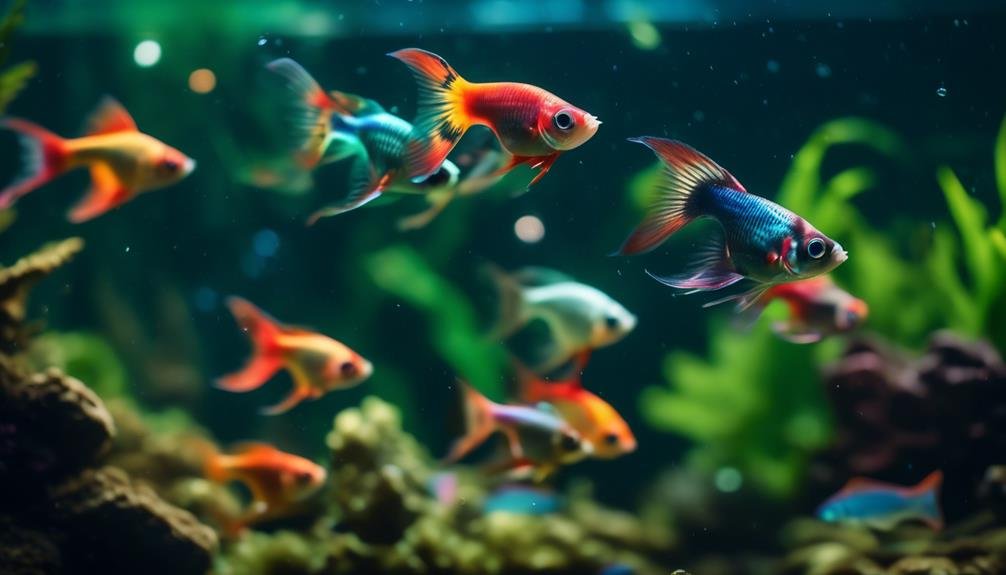
When considering tank mates for guppies, one excellent option to consider is adding tetras to your aquarium. Tetras come in many different varieties and are suitable for both newbie and experienced aquarists. They've bright colors that stand out in any aquarium and most tetra species are peaceful by nature.
Tetras are easy to care for and thrive in planted tanks. Some popular choices include the Neon Tetra, Cardinal Tetra, and Bleeding Heart Tetra. These tetras are small in size but have vibrant colors, making them suitable for planted tanks. They do best when kept in groups of their own species and are great choices for community tanks.
Adding tetras to your guppy tank will create a visually appealing and dynamic aquatic environment.
Choosing the Right Lighting System
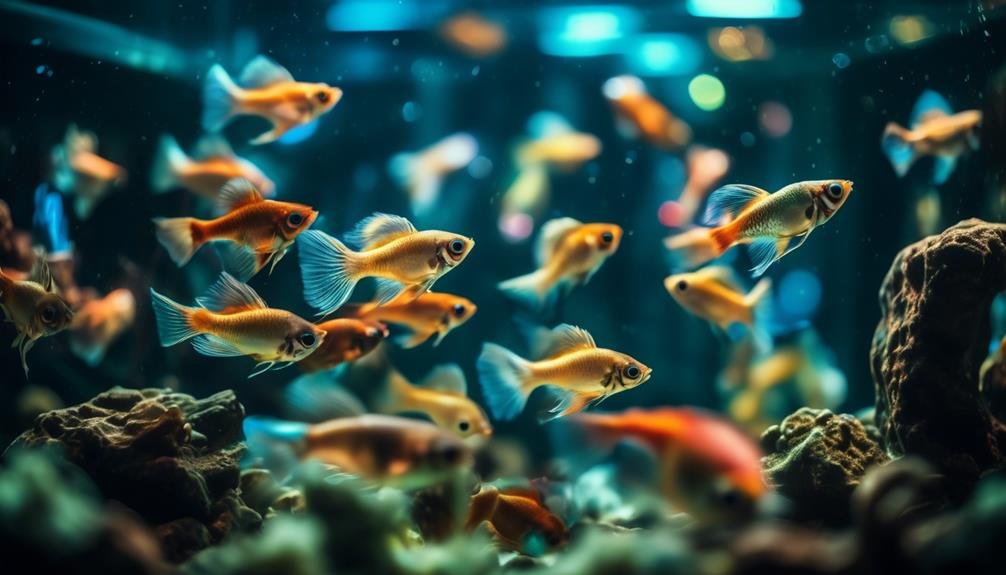
When it comes to creating the perfect environment for your planted aquarium, choosing the right lighting system is crucial for the health and growth of your aquatic plants. Proper lighting enhances the photosynthesis process, allowing plants to produce the energy they need to thrive.
There are various lighting systems available, but the four best types for planted aquariums are fluorescent, compact fluorescent, LED, and metal halide.
- Fluorescent lights are affordable and provide a good amount of light for most plants.
- Compact fluorescent lights are energy-efficient and emit a higher intensity of light.
- LED lights are long-lasting and customizable, allowing you to adjust the color and intensity.
- Metal halide lights are intense and suitable for large and deep tanks.
Consider the specific needs of your plants and choose a lighting system that provides the right spectrum and intensity for optimal growth.
Benefits of Proper Lighting for Plants
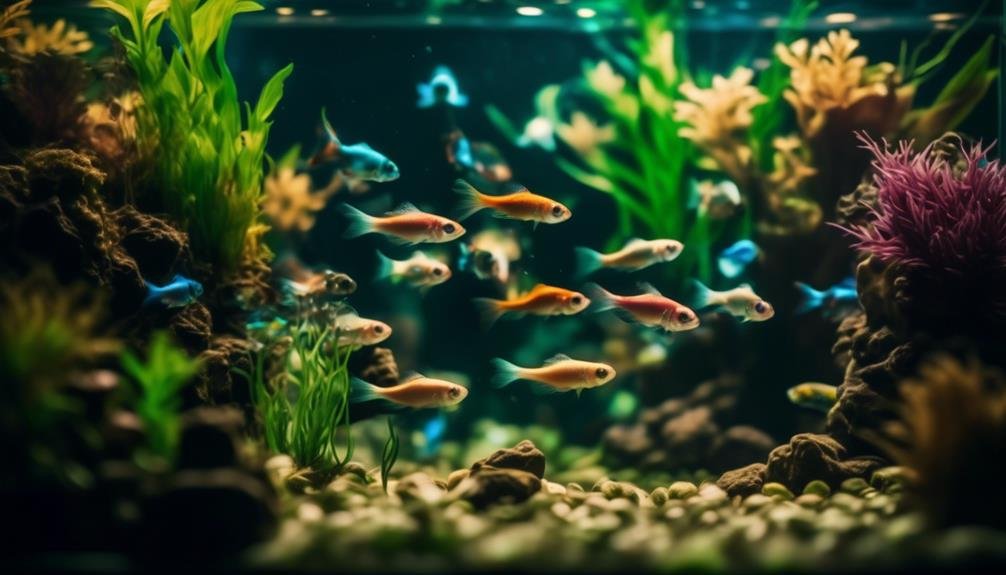
Proper lighting for your planted aquarium is essential for the health and growth of your aquatic plants, ensuring they receive the necessary energy to thrive and flourish. Here are the benefits of providing your plants with the right lighting:
- Enhanced Photosynthesis: Adequate lighting promotes photosynthesis, the process by which plants convert light energy into chemical energy. This energy is crucial for the plants' growth and development.
- Balanced Growth: Proper lighting helps plants maintain a balanced growth pattern, preventing them from becoming elongated or stunted. It also encourages the growth of healthy leaves and roots, ensuring overall plant vitality.
- Vibrant Colors: The right lighting brings out the vibrant colors of your aquatic plants, making your aquarium visually appealing. It highlights the natural beauty and adds a lively touch to your underwater landscape.
Types of Lighting Systems
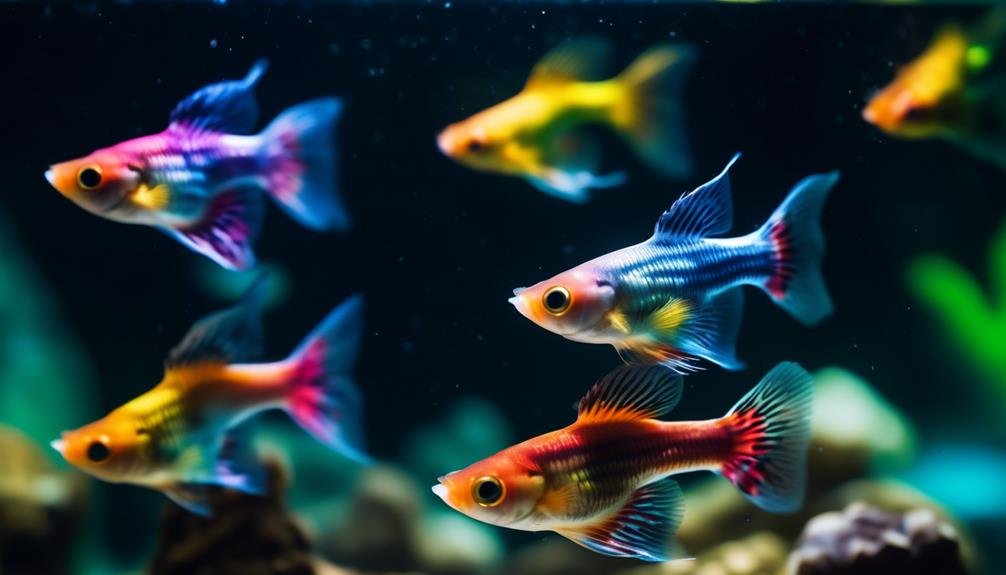
To explore the different types of lighting systems for planted aquariums, let's delve into their features and benefits. The right lighting system is crucial for the health and development of your aquarium plants. It not only enhances their growth but also creates a visually appealing tank. Different lighting systems cater to different plant species, so it's important to choose the one that suits your plants' needs. Here are four of the best types of lighting systems for planted aquariums:
| Type of Lighting System | Features | Benefits |
|---|---|---|
| Incandescent | Affordable and widely available | Suitable for low-light plants |
| Fluorescent | Energy-efficient and long-lasting | Ideal for medium-light plants |
| LED | Energy-efficient and customizable | Suitable for all types of plants |
| Metal Halide | High-intensity light | Ideal for high-light plants |
Each lighting system has its own advantages, so consider the needs of your plants when selecting the right one for your planted aquarium.
Importance of Adequate Lighting for Plant Health
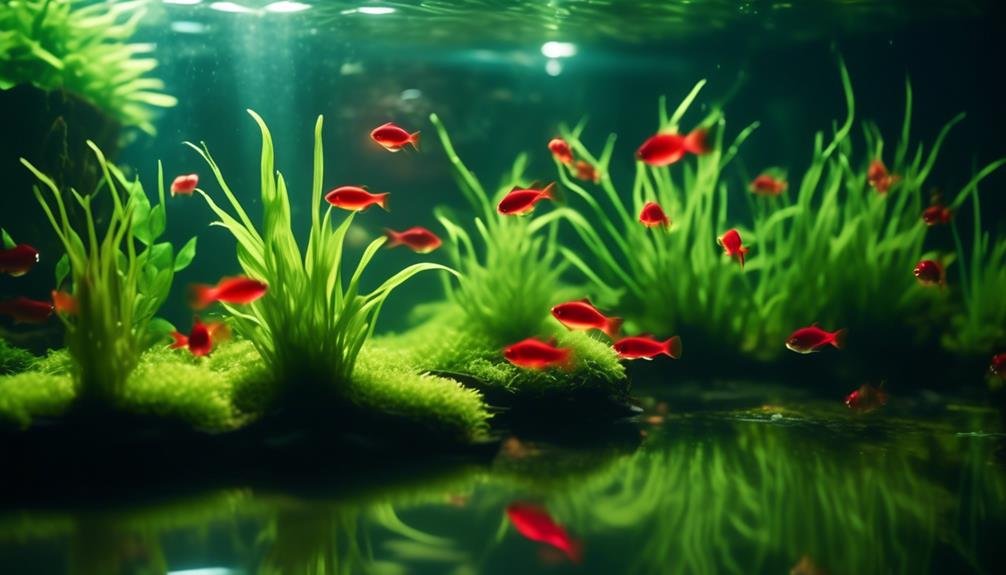
Having adequate lighting is essential for maintaining the health and vitality of your aquarium plants. Proper lighting not only enhances the growth of your plants but also creates a visually appealing tank.
Here are three reasons why adequate lighting is crucial for plant health:
- Photosynthesis: Plants rely on light to carry out photosynthesis, a process that converts light energy into chemical energy, allowing them to grow and thrive. Adequate lighting ensures that plants have enough energy to carry out this vital process.
- Nutrient Absorption: Light plays a crucial role in the absorption of nutrients by plants. Without sufficient light, plants may struggle to take in essential nutrients, leading to stunted growth and poor overall health.
- Algae Control: Adequate lighting helps to prevent excessive algae growth in your aquarium. By providing the right amount of light for your plants, you can create a balanced environment that discourages algae from taking over.
Investing in a quality lighting system is a crucial step in creating a thriving planted aquarium.
Frequently Asked Questions
How Do I Breed Guppies?
To breed guppies, set up a separate breeding tank with plants and hiding spots. Introduce a male and female guppy. The female will give birth to live young. Separate and care for the fry.
Can Guppies Live in a Community Tank With Aggressive Fish?
Yes, guppies can live in a community tank with aggressive fish, but it's important to choose suitable tank mates. Mollies, platys, swordtails, smaller tetras, gouramis, and rasboras are all peaceful options that can coexist with guppies.
What Is the Lifespan of a Guppy Fish?
The lifespan of a guppy fish can vary, but on average, they live for about 2 to 3 years. However, with proper care and a healthy environment, some guppies can live up to 5 years or more.
Can Guppies Tolerate High Temperatures in the Aquarium?
Yes, guppies can tolerate high temperatures in the aquarium. They are hardy fish and can handle temperatures up to 82°F. Just make sure to monitor the water temperature and provide proper filtration.
Are Guppies Prone to Any Specific Diseases or Health Issues?
Guppies are generally hardy fish, but they can be prone to diseases like fin rot, ich, and dropsy. Regular water changes, proper filtration, and a balanced diet can help prevent these issues.
Are Guppies and Filefish Both Suitable Choices for Beginner Fishkeepers?
Yes, guppies and filefish for beginners are both suitable choices for beginner fishkeepers. Guppies are known for their hardiness and vibrant colors, making them ideal for new hobbyists. Meanwhile, filefish can adapt well to tank life and are relatively low maintenance, making them a good option for novice fishkeepers.
Conclusion
So there you have it, a glimpse into the vibrant and enchanting world of guppies!
These small, non-aggressive freshwater fish are perfect for beginners and experienced aquarists alike.
With their peaceful temperament and beautiful appearance, guppies are sure to captivate you.
Don't forget to consider suitable tank mates like gouramis and rasboras, and invest in the right lighting system to ensure the health and growth of your aquarium plants.
Get ready to dive into the world of guppies and create a stunning underwater paradise!




